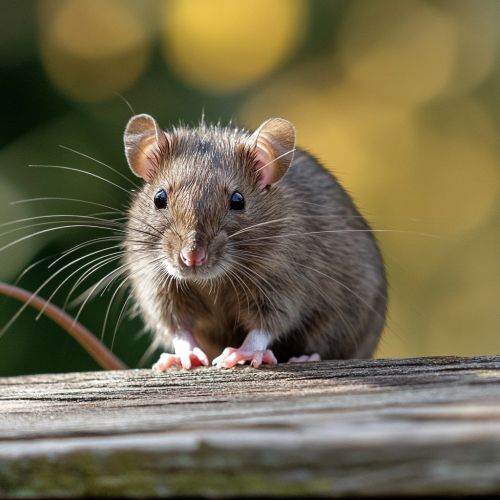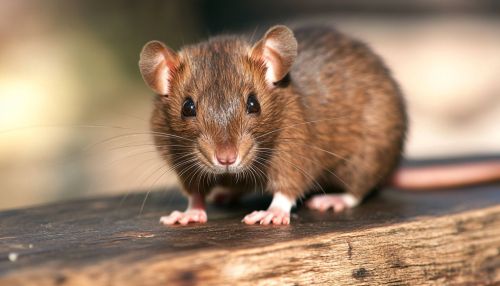Rats: Difference between revisions
(Created page with "== Introduction == Rats are medium-sized, long-tailed rodents belonging to the superfamily Muroidea. The genus Rattus, the most significant to humans, includes the black rat (Rattus rattus) and the brown rat (Rattus norvegicus). These species are often referred to as the "true rats" and are known for their adaptability to various environments, making them one of the most widespread mammals on Earth. == Taxonomy and Evolution == Rats belong to the order Rodentia, which i...") |
No edit summary |
||
| Line 19: | Line 19: | ||
Rats are prolific breeders with a high reproductive rate. Female rats have a bicornuate uterus, and their estrous cycle lasts about four to five days. Gestation lasts approximately 21 to 23 days, and a single litter can consist of 6 to 12 pups. Rats reach sexual maturity at around five weeks of age. | Rats are prolific breeders with a high reproductive rate. Female rats have a bicornuate uterus, and their estrous cycle lasts about four to five days. Gestation lasts approximately 21 to 23 days, and a single litter can consist of 6 to 12 pups. Rats reach sexual maturity at around five weeks of age. | ||
[[Image:Detail-98015.jpg|thumb|center|A brown rat sitting on a wooden surface.|class=only_on_mobile]] | |||
[[Image:Detail-98016.jpg|thumb|center|A brown rat sitting on a wooden surface.|class=only_on_desktop]] | |||
== Behavior and Ecology == | == Behavior and Ecology == | ||
Latest revision as of 22:47, 19 September 2024
Introduction
Rats are medium-sized, long-tailed rodents belonging to the superfamily Muroidea. The genus Rattus, the most significant to humans, includes the black rat (Rattus rattus) and the brown rat (Rattus norvegicus). These species are often referred to as the "true rats" and are known for their adaptability to various environments, making them one of the most widespread mammals on Earth.
Taxonomy and Evolution
Rats belong to the order Rodentia, which is characterized by a single pair of continuously growing incisors in each of the upper and lower jaws. The family Muridae, to which rats belong, is the largest family of mammals, encompassing over 700 species. The genus Rattus is part of the subfamily Murinae, which also includes mice and other small rodents.
The evolutionary history of rats is complex and involves multiple radiations and dispersals. Fossil evidence suggests that the ancestors of modern rats originated in Asia and spread to other continents. The diversification of the genus Rattus occurred during the Miocene epoch, approximately 14 million years ago.
Anatomy and Physiology
Rats have a robust body structure with a pointed snout, large ears, and a long, scaly tail. Their fur is typically coarse and can vary in color from brown to black. The average body length of a rat ranges from 20 to 25 cm, with the tail adding an additional 15 to 22 cm.
Skeletal System
The skeletal system of rats is adapted for agility and burrowing. They possess a flexible spine, allowing them to squeeze through narrow spaces. Their limbs are equipped with sharp claws for digging and climbing. The dental formula of rats is 1.0.0.3/1.0.0.3, indicating one pair of incisors and three pairs of molars on each jaw.
Digestive System
Rats have a highly efficient digestive system capable of processing a wide variety of foods. Their stomach is divided into a forestomach and a glandular stomach, aiding in the initial breakdown of food. The cecum, a pouch connected to the junction of the small and large intestines, plays a crucial role in the fermentation of fibrous plant material.
Reproductive System
Rats are prolific breeders with a high reproductive rate. Female rats have a bicornuate uterus, and their estrous cycle lasts about four to five days. Gestation lasts approximately 21 to 23 days, and a single litter can consist of 6 to 12 pups. Rats reach sexual maturity at around five weeks of age.


Behavior and Ecology
Rats are highly adaptable and exhibit a wide range of behaviors that contribute to their survival in diverse environments. They are primarily nocturnal and have keen senses of smell, hearing, and touch, which they use to navigate and find food.
Social Structure
Rats are social animals that live in colonies with complex social hierarchies. Dominance is established through aggressive interactions, and dominant individuals have priority access to resources such as food and mates. Communication within colonies involves vocalizations, scent marking, and body language.
Foraging and Diet
Rats are omnivorous and opportunistic feeders. Their diet includes grains, fruits, vegetables, insects, and small animals. In urban environments, they scavenge human food waste. Rats exhibit food hoarding behavior, storing surplus food in burrows or nests for future use.
Habitat
Rats are found in a variety of habitats, including forests, grasslands, wetlands, and urban areas. They are highly adaptable and can thrive in both natural and human-modified environments. In urban settings, rats often inhabit sewers, basements, and attics.
Impact on Human Society
Rats have a significant impact on human society, both positive and negative. They are known for their role in the spread of diseases, agricultural damage, and as subjects in scientific research.
Disease Vectors
Rats are vectors for several zoonotic diseases, including leptospirosis, hantavirus, and salmonellosis. The most infamous disease associated with rats is the bubonic plague, caused by the bacterium Yersinia pestis, which is transmitted by rat fleas.
Agricultural Pests
Rats cause substantial damage to crops and stored food products. They consume and contaminate large quantities of food, leading to significant economic losses. Effective pest control measures are essential to mitigate their impact on agriculture.
Scientific Research
Rats are widely used in laboratory research due to their physiological and genetic similarities to humans. They serve as model organisms in studies of genetics, neuroscience, and pharmacology. The development of transgenic rat models has advanced research in various fields, including cancer and cardiovascular diseases.
Conservation and Management
The management of rat populations involves a combination of preventive measures, population control, and habitat modification. Conservation efforts focus on protecting native species and ecosystems from the invasive impact of rats.
Population Control
Population control methods include trapping, poisoning, and biological control. Integrated pest management (IPM) strategies combine these methods with environmental modifications to reduce rat populations effectively. The use of rodenticides must be carefully managed to avoid non-target species and environmental contamination.
Habitat Modification
Habitat modification involves altering the environment to make it less conducive to rat habitation. This includes securing food sources, sealing entry points in buildings, and maintaining cleanliness in urban areas. Public awareness and community involvement are crucial for the success of these measures.
Conservation of Native Species
Invasive rat species pose a significant threat to native wildlife, particularly on islands. Conservation efforts include eradication programs and the restoration of native habitats. Successful eradication campaigns have been conducted on several islands, leading to the recovery of native species and ecosystems.
Cultural Significance
Rats have been depicted in various cultural contexts, ranging from symbols of fertility and prosperity to representations of disease and filth. Their portrayal in literature, mythology, and art reflects the complex relationship between humans and rats.
Mythology and Folklore
In Chinese zodiac, the rat is one of the twelve animals and is associated with qualities such as intelligence, adaptability, and resourcefulness. In Indian mythology, the rat is the vehicle of Lord Ganesha, symbolizing wisdom and foresight.
Literature and Media
Rats have been featured in numerous literary works and films, often as symbols of cunning and survival. Notable examples include the character of Templeton in E.B. White's "Charlotte's Web" and the animated film "Ratatouille," which portrays a rat aspiring to be a chef.
